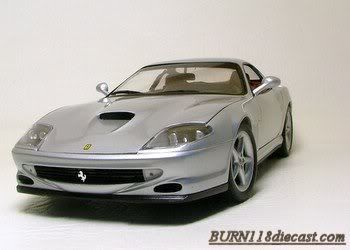
In 1996, Ferrari
had announced that their top car, their ultimate driving experience, would no
longer be a mid engined F1 based road car, but instead, a front engined GT.
Many doubts had arisen about Ferrari, but the new release, the front engined
550 Maranello removed any doubt. Ferrari was still doing elegant but
spectularly powerful beasts. Many diecast manufacturers replicated this model,
this one being the UT version of 1996 in silver.
The paintjob is very smooth and very well made. I have no defects on mine. The
shade of silver looks perfectly replicated aswell. The proportions of this
model look perfect and after comparing the actual size with the model, I can
say that the model is a true
1:18
model.
Exterior detailing
on this car is great. All shutlines are very small and it sits very nicely. All
the lines of the real thing are well replicated and all grills are actually
perforated pieces or very well made. The car just has one decal, the front
badge. The rear �Ferrari� and prancing horse symbol are both photo-etched
pieces. The exhausts are well defined and coloured well, they are hollow and I
cannot see their end. Pretty
impressed by the exterior care UT gave to this car.
However, the
lights could have been much better. Each front hub is composed by one large
circular headlight, one small one and one semispherical light/indicator. On the
model, the semispherical light does not have the orange indicator piece on, but
its all silver. Futhermore, the light bulb should be extremely visible but
instead its one smooth piece. The fog lights are positioned correctly as well,
but the attachment stub is quite visible. The rear lights are accurately
replicated, my only real reprimand is that the white and orange spots should
not be so bright.
The rim is
accurately made, but that is probably the sole
high point
. The tyres are not branded and are cut tyres. The paint used on the
rims has the usual UT paint effect and is coming off gradually. I touched it up
in some areas and now seems fine. The wheels are not solidly put into the
chasis and have the habit of coming off easily.
The brake detail is quite visible
thanks to the loose wheels. The disk rotates and the caliper is static. The
brake disk does not have drilled holes but they are just coloured. The caliper
has Ferrari written on it.
The model�s doors,
engine cover and rear compartment do open. All parts keep open but on a
negative note, they are all supported by quite large doglegs. Shutlines are
very small, I had a hard time to open the engine cover myself!
The
rear compartment is quite simple, no carpet at all, just a black piece of
plastic. The engine is �well� made. As with most modern cars, the engine is
completely sealed and only a few details can be seen. Most parts are separate
pieces of plastic and coloured differently, even though, most of it is black. I
feel UT could have added a lot of realism to this engine.
The interior
of this car is very elegant and refined in red, black and chrome. UT replicated
acceptably. The dashboard and center console is very well made, detailed and
accurate. However, the seats, even though accurate, have a toyish feel to them.
They are made with hard plastic and coloured in pale red, do not do a good job
in replicating leather. Futhermore, there are no seatbelts. The floors are not
carpeted neither.
After
comparing the undercarriage with the real car�s I can easily say that UT made a
great effort. It is strikingly accurate with the exception of a couple of parts
that should be in silver, UT made them in black. Of course there are the
traditional screws but they are not that visible.
